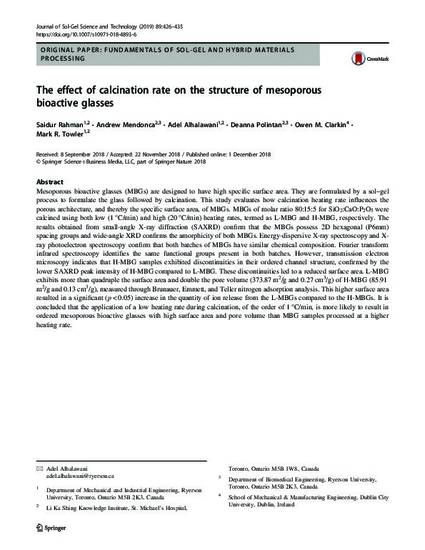
Mesoporous bioactive glasses (MBGs) are designed to have high specific surface area. They are formulated by a sol–gel process to formulate the glass followed by calcination. This study evaluates how calcination heating rate influences the porous architecture, and thereby the specific surface area, of MBGs. MBGs of molar ratio 80:15:5 for SiO2 :CaO:P2 O 5 were calcined using both low (1 °C/min) and high (20 °C/min) heating rates, termed as L-MBG and H-MBG, respectively. The results obtained from small-angle X-ray diffraction (SAXRD) confirm that the MBGs possess 2D hexagonal (P6mm) spacing groups and wide-angle XRD confirms the amorphicity of both MBGs. Energy-dispersive X-ray spectroscopy and X-ray photoelectron spectroscopy confirm that both batches of MBGs have similar chemical composition. Fourier transform infrared spectroscopy identifies the same functional groups present in both batches. However, transmission electron microscopy indicates that H-MBG samples exhibited discontinuities in their ordered channel structure, confirmed by the lower SAXRD peak intensity of H-MBG compared to L-MBG. These discontinuities led to a reduced surface area. L-MBG exhibits more than quadruple the surface area and double the pore volume (373.87 m2 /g and 0.27 cm3 /g) of H-MBG (85.91 m2 /g and 0.13 cm3 /g), measured through Brunauer, Emmett, and Teller nitrogen adsorption analysis. This higher surface area resulted in a significant (p < 0.05) increase in the quantity of ion release from the L-MBGs compared to the H-MBGs. It is concluded that the application of a low heating rate during calcination, of the order of 1 °C/min, is more likely to result in ordered mesoporous bioactive glasses with high surface area and pore volume than MBG samples processed at a higher heating rate. [Figure not available: see fulltext.].
Available at: http://works.bepress.com/mark-towler/144/
Canadian Institutes of Health Research, Grant 366716